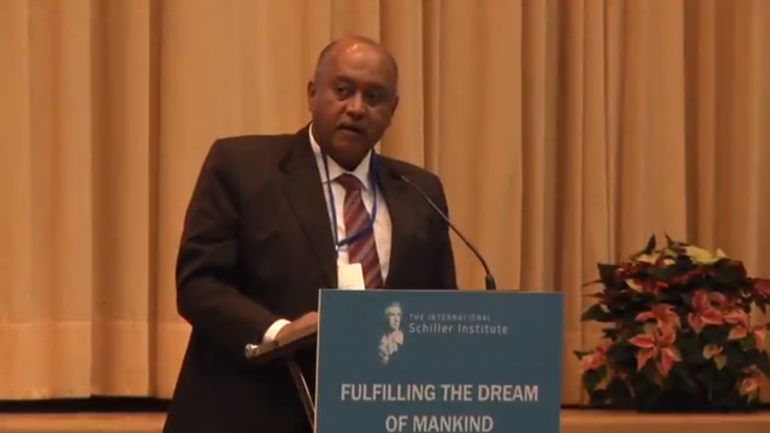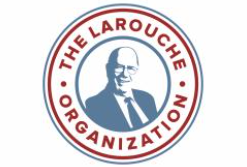in the Industrialization of Africa
Mehreteab Mulugeta Haile,
General Consul of the Federal Democratic
Republic of Ethiopia, Frankfurt am Main.
Video; english transcript

The Need for Europe to Cooperate with China in the Industrialization of Africa
Mr. Mehreteab Mulugeta Haile is Consul General of Ethiopia in Frankfurt. This is an edited transcript of his address to the International Schiller Institute conference on “Fulfilling the Dream of Mankind,” Nov. 25-26, 2017, in Bad Soden/ Taunus, Germany. Subtitles have been added.
Transcript
Mrs. Helga Zepp-LaRouche, President and Founder of the Schiller Institute, distinguished participants, ladies and gentlemen, at the outset, allow me to thank and express my appreciation to the Schiller Institute for organizing conferences that help shed light on current political and economic developments in the world. I feel honored and I am thankful to be invited and to make a speech at this august gathering.
Today, I will talk about Ethiopia’s rapid economic development and its involvement in regional cooperation, and contributions made by Europe and China to enhance these developments.
Ethiopia is one of the largest Least Developed Countries (LDCs) in Sub-Saharan Africa, with a population of about 100 million people. After suffering economic stagnation for decades, its economy began to grow in the mid-1990s after a new administration led by the Ethiopian People’s Revolutionary Democratic Front (EPRDF) took the helm of government.
For the last 15 years, Ethiopia has become one of the fastest growing economies in the world, with an average Gross Domestic Product (GDP) growth rate of about 11% per annum. To continue with this rapid economic growth, the Ethiopian Government rolled out, in 2010, an ambitious five-year Growth and Transformation Plan (GTP) that aims to attain a lower-middle-income status by 2025. Currently the country is implementing the second Growth and Transformation Plan (GTP II), which is built on Sectoral Policies, Strategies & Program and Lessons drawn from the implementation of the first GTP and the post-2015 “sustainable development goals” (SDGs). It has also taken into account global and regional economic situations having direct or indirect bearing on the Ethiopian economy.
GTP II aims, for the coming 8 to 10 years, to continue achieving an annual average real GDP growth rate of 11% within a stable macroeconomic environment, while at the same time pursuing aggressive measures towards rapid industrialization and structural transformation. To this end, concerted and coordinated effort will be made so that equitable economic growth translates into creating job opportunities accompanied by significant poverty reduction. Agriculture will be maintained as a major source of growth, while the development of industries by accelerating industrial development will be supplemented with the promotion of the service sector, so as to enhance growth. To this effect, coordinated and strong forward and backward production linkages will be strengthened. Private sector investment will be promoted through providing the necessary incentives and support, to enhance private sector participation in allowed investment areas.
Expansion of infrastructure development—such as road, railway, dry port, air transport, energy, telecommunications, water, and irrigation schemes—will have special consideration in GTP II.
Industry and Infrastructure Development
During GTP II, industrial development and structural transformation is expected to bring significant growth of the manufacturing industry, so that it plays the leading role in the overall economic development of the country. Implementation strategies mainly focus on implementation of projects and programs which are geared towards attracting quality investment, enhancing production and productivity, boosting export shares, accelerating technological learning, and strengthening the linkage among industries. To this end, establishing 12 industrial parks and clusters has been undertaken in the country, with 7 million square meters of land made available for investors engaged in manufacturing and related sectors. Four agro-industrial parks will also be established which will be linked with millions of smallholder farmers supplying input. Regional administrative areas, cities and towns will get the necessary support to develop standardized industrial clusters and parks for those investors promoting small to medium-size industries, and hence generate employment opportunities.
Expanding the manufacturing sector will focus on identifying new investment areas such as biotechnology, petrochemicals, electricity and electronics, information and communication technologies (hardware and software production industries).
In the infrastructure sector, the overall strategic direction is to ensure the creation of infrastructure that supports rapid economic growth and structural transformation. This direction will create mass employment opportunities, an institution having strong implementation capacity, ensure public participation and benefit, construct decentralized infrastructure development systems, solve financial constraints, ensure fairness and profitability, and ensure integrated planning and administration of infrastructure development.
Within infrastructure overall, rural roads are given high focus—to help reduce poverty by facilitating easy access of agricultural products, at low transportation cost, to the market, improving access to basic socioeconomic services, and strengthening rural-urban linkages.
Thus, the major strategic directions of the road development sector during GTP II will be ensuring the existence and sustainability of road infrastructure network with quality and safety, as well as to improve the provision of road infrastructure, by expanding the road network both in terms of quantity and quality, to sustain and ensure current and future economic growth.
The other area that has been given major emphasis is the energy sector. The main objective of the sector during GTP II is increasing national energy generation, transmission, and distribution capacity to fully satisfy domestic energy demand with production surplus ready for the export market. Implementation strategies are set, to increase electric power generating capacity through initiatives in hydro power, wind power, geothermal power, and solar power.
The other major project in the area of infrastructure building is railway development. The major strategic direction of railways infrastructure development during GTP II is to continue the network expansion started under GTP I, build capacity by establishing a modern railway industry academy, and make it operational; develop various railway industry standards; ensure that railway transport services are in accordance with standards, and conduct problem solving research on railway infrastructure building, operations, and service provision.
The objectives of the construction industry during the GTP II period are to build the capacity of the industry in a sustainable way, ensure the efficiency and effectiveness of construction procurement and contract management, develop internationally competent contractors and design & construction consultants, and improve the availability of construction raw materials and machinery for those engaged in construction and housing development programs.
Regional and International Development
We in Ethiopia believe that economic development in a secluded situation cannot be sustainable and attainable. To this end, Ethiopia, through the Intergovernmental Authority for Development (IGAD), is increasingly collaborating with its neighbors—notably Kenya, Sudan, Djibouti, Sudan, and South Sudan—in the areas of trade, tourism, industry, infrastructure development, and energy, among others. The Ethiopian private sector is increasingly encouraged to invest in those countries and all these countries are thus enhancing their economic cooperation. We in Ethiopia are striving to bring regional economic integration to create a larger regional market for trade and investment and make use of the advantages of efficiency, productivity gains, and competitiveness. In recent years the Ethiopian government has taken steps to enhance non-trade aspects of economic cooperation, which could strengthen economic ties among the countries in the region.
IGAD’s focus on regional economic cooperation and integration is to create an open, unified, regional economic space for the business community—a single market open to competitive entry and well integrated into the continental and global economies. This focus requires both regional infrastructure as well as the gradual harmonization of policies for the removal of barriers to inter-state communications.
The European Union and other development partners are actively supporting and participating in economic development activities in Ethiopia. Through its development cooperation, the EU stands by Ethiopia in addressing its key challenges, such as food insecurity, rapidly growing population, environmental pressures exacerbated by climate change, low industrial output, and a range of governance issues. In recent years, the EU+ group disbursed annually around 1 billion euros in official development assistance (ODA), equivalent to roughly a quarter of the total external aid to Ethiopia, and it may reach up to 10% of the country’s annual federal budget in certain years. In this context, joint programming is not only about aid effectiveness, but most importantly, has a strong political dimension and is one of the instruments in support of the implementation of the wider EU-Ethiopia strategic engagement. The European Union supports the efforts of Ethiopia to eradicate poverty, and to foster inclusive and sustainable economic, social, and environmental development while promoting human rights, democracy, and other elements of good governance.
For the last three years, much focus has been given to the issue of migration and its management by European countries. Ethiopia is a key partner in the stability and management of migratory flows in the region, due to its role in hosting large numbers of refugees from neighboring countries, its proactive policy of fighting traffickers and smugglers, and the interest of Ethiopians in migrating to neighboring countries and regions in search of work. Ethiopia is one of the five priority countries identified in the Communication on Establishing a New Partnership Framework with Third Countries under the European Agenda on Migration. Through the EU Trust Fund for Africa, EU actions address the root causes of irregular migration in the most migrant-prone regions of the country, promoting economic and employment opportunities, particularly for vulnerable people, through vocational training, access to micro-finance, or by creating industrial parks. Actions also aim to strengthen resilience and combat the drivers of instability, to improve long-term development and protection needs of refugees and their host communities, and to better manage migration at regional level.
When we look at the role Germany is playing in the relationship of African countries with EU countries, in general, and Ethiopia in particular, we find that Germany has made cooperation with Africa a core element of its G-20 Presidency. The German government advocates for a G-20 Africa Partnership and has put in place the G-20 Compact with Africa, which aims to promote private investment, sustainable infrastructure, and job creation in African countries. Germany’s Minister of Finance describes the Compact with Africa as a “long-term, demand-driven process” in which “African countries will determine what they want to do to improve conditions for private investment, with whom they want to cooperate, and in what form.”
China and Africa
Last year, during its G-20 Presidency, China made Africa a prominent part of the G-20 agenda, with an unprecedented number of African leaders participating in the G-20 Summit in Hangzhou and with commitments to support industrialization and the proliferation of renewable energy in African countries.
According to data from China’s Ministry of Commerce (MOFCOM), the stock of Chinese direct investment in Africa was $32 billion at the end of 2014. Of course, direct investment is not the only form of foreign financing. The Export-Import Bank of China and China Development Bank have made large loans in Africa, mostly to fund infrastructure projects. In recent years, China has provided about one-sixth of the external infrastructure financing for Africa. In short, Chinese financing is substantial enough to contribute meaningfully to African investment and growth. However, the notion that China has provided an overwhelming amount of finance and is buying up the whole continent is inaccurate.
If we take my country, Ethiopia, as an example of Chinese cooperation and involvement in Africa, we find that what has been said above is false. According to the Ethiopian Investment Commission, Chinese companies, with close to 379 projects that were either operational or under implementation in the 2012-2017 period, are on top of Ethiopia’s investment landscape, both in number and financial capital. Among these companies, 279 were operational with projects that are worth over 13.16 billion Ethiopian birr (over 572 million U.S. dollars) during the reported period, while the remaining 100 are under implementation.
In terms of employment creation, Chinese companies have created more than 28,300 jobs in various sectors in Ethiopia during the reported period, of which over 19,000 were created in Ethiopia’s manufacturing, as it is the leading sector in attracting companies from China. China brings not only investment, knowhow, and transfer of technology, but also skills and entrepreneurship.
At this point, I would like to mention the initiative taken by His Excellency President Xi Jinping in 2013, the “One Belt, One Road” (OBOR) Initiative. This is President Xi’s “project of the century.” It is based on the legendary Silk Road, which connected Europe and China for one and a half millennia. The aim of China’s OBOR project is to open up and expand old Silk Road trade routes through Central Asia and on to Europe, as well as Southeast Asian maritime links through the Strait of Malacca and around India to the Middle East. Xi’s ambitious goals do sound inspiring indeed: “We should build the Belt and Road into a road of peace . .. of prosperity … of opening up .. . of innovation . .. connecting civilizations,” he said. The total trade between China and other Belt and Road countries has exceeded $3 trillion. China’s investment has surpassed $50 billion. Chinese companies have created almost 200,000 jobs and over $1 billion of tax revenue. China is generating mutual benefits by creating jobs and supporting the domestic economy of those countries in which it is investing.
The Jamestown Foundation’s China Brief stated this month (paraphrase):
OBOR will bring a greater effect on local and regional integration along the way, especially for Ethiopia and other countries in the region. The Maritime Silk Road will have a significant impact both because of economic integration on a local level, and by forging connections between East Africa and neighboring regions. It also connects regional centers to each other. OBOR could partly ease a problem that has bedeviled African development since the end of the colonial era. It also has the potential to facilitate trade and shared manufacturing between different East African economies. In this sense, the OBOR initiative has the potential to achieve a certain amount of regional integration—a long-held ideal of African development. OBOR presents an intriguing perspective on the sometimes highly unequal nature of south-south cooperation, and raises questions about the nature of African agency in the 21st Century.
German-Chinese-African Development
It is estimated that Africa needs to create about 20 million jobs per year to employ its expanding workforce. Africa’s demographics present both an opportunity and a challenge to the rest of the world. It is unrealistic to expect Europe or China to tackle the problems of African countries alone and bring a change overnight. Nor would it be reasonable to expect large volumes of Chinese or European manufacturing to move to the continent in the near future. Therefore, it is useful to have a long-term vision of economic relationship that very much centers on the utilization of natural resources of Africa and the shift over time to a greater focus on human resources development by creating jobs. To this end, trilateral cooperation would provide an ideal opportunity for Germany and China, as the current and previous G-20 Presidencies, to jointly demonstrate their commitments under the G-20 to increase support for African countries. This form of cooperation complements and brings together the traditional NorthSouth and South-South cooperation models. In line with the Compact with Africa, such cooperation needs to be guided by the African Union’s Agenda 2063 and African countries’ national development plans in order to be successful.
The launch of the Sino-German Center for Sustainable Development in Beijing in May is a promising step in this direction, as the center plans to support sustainable infrastructure development in African countries. This can, indeed, be an area in which African countries can benefit from joint cooperation between Germany and China. China has a comparative advantage in the provision of cost-effective infrastructure development, while the sustainability of such projects can be ensured by making use of Germany’s expertise in project management, social and environmental impact assessments, and quality assurance.
Germany and China should also foster trilateral cooperation with African countries on industrialization and renewable energy. The joint establishment of special economic zones (SEZs) in African countries would be a good starting point. SEZs were a key component of China’s economic development and are also starting to play an important role for industrialization in African countries such as Ethiopia. A trilateral SEZ project should utilize China’s profound experience in financing, developing, and managing SEZs, while Germany would contribute its expertise in preparing and delivering tailored technical vocational education and training programs for different sectors. Germany’s understanding of social and environmental standards and its international marketing insights would also help ensure that SEZs are attractive for investors and suitable for global supply chains.
There is also a huge potential for effective trilateral cooperation between Germany, China, and African countries on the proliferation of renewable energy in Africa. The African Union’s recently launched Africa Renewable Energy Initiative (AREI) provides a possible entry point, as both China and Germany have individually pledged their support for the initiative. Both countries are global leaders in renewable energy policy and technology, and have considerable experience working with African countries bilaterally in these areas. A trilateral project should focus on a so far overlooked, but crucial component in the establishment of the Africa Renewable Energy Institute, namely, to serve as the initiative’s backbone for research and training. Germany and China could build on the experiences from the establishment and operation of similar institutes in China, such as the China-EU Institute for Clean and Renewable Energy, and engage these institutes and their networks to build new partnerships.
Thank you.






